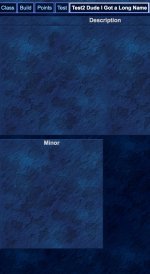I've seen discussion on agents being a new way to do things. Using "isagent <> 0" and agent.field[] with a configurable. Is there a link to docs for this? What is the advantage of this new feature?
I'd like to make a class tab for a custom game system that uses the list from the pathfinder class tab with the ability of the user to move levels up and down. I can't seem to find code that does this? Does someone have a code snip for this or can point me to the docs for the table method? (<table_dynamic>?)
I'd like to make a class tab for a custom game system that uses the list from the pathfinder class tab with the ability of the user to move levels up and down. I can't seem to find code that does this? Does someone have a code snip for this or can point me to the docs for the table method? (<table_dynamic>?)
Last edited:


